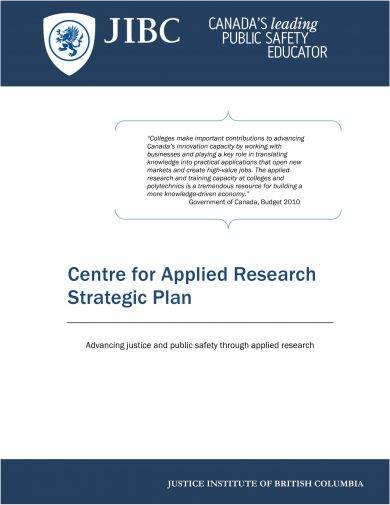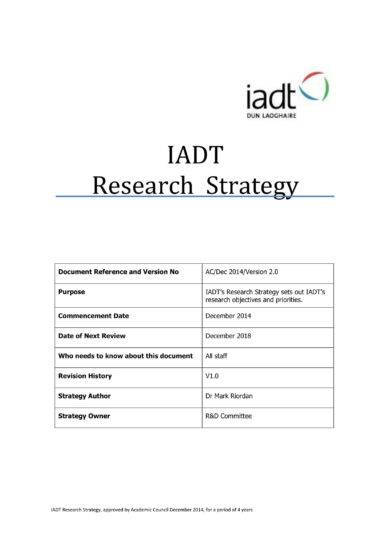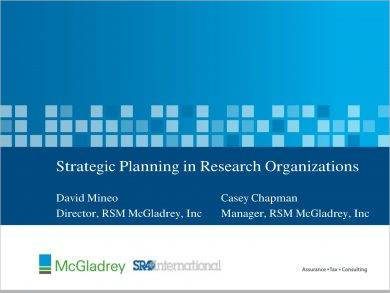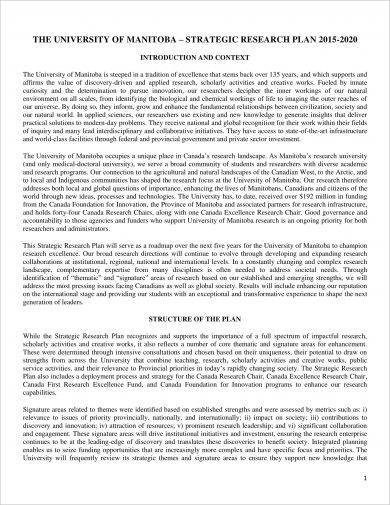9+ Research Strategic Plan Examples to Download
Before doing anything else, especially when you are dealing with important matters such as researches, you need to plan your way through as well as the steps needed in order to have a progress toward achieving a certain goal. Without proper planning and preparation, there is a great tendency that the tasks we do will not be in line with our professional goals. We may end up doing something else, consuming most of our time in unnecessary tasks.
On the other hand, with planning, we will be guided in whatever we do and we can constantly check our progress in the path that we are taking. We can monitor things if they are still in accordance with our plan and take necessary actions to keep it on track and in line with our goals in cases when we got derailed. You may also see recruitment strategy plan examples.
The dos and don’ts with regard to strategic planning can be found in the later section of this article. For now, you may check the next section for some useful examples of research strategic plan.
Applied Research Strategic Plan Example
Aurora Research Institute Research Strategic Plan Example
IADT Research Strategic Plan Example
Dos and Don’ts in Strategic Planning
A lot of entities in different in industries adopted strategic planning since it is proven helpful in the first stage of achieving a certain goal and in preparing and monitoring for the execution of tasks needed to be taken in order to achieve the planned goals. Planning must be paired with and completed through proper execution for the efforts in planning alone without proper execution is in vain.
Here are some dos and don’ts that you need to know as regards strategic planning. You must be mindful of these things for you to be focused on the right track on your strategic planning.
Dos in Strategic Planning
Here are some things that you must do in your strategic planning for it to be effective and working:
1. Do lay down your goals, missions, and objectives. This is among the first things that you must determine so that you will know where you are going. These are the things that you need to achieve, the reason why you are having your strategic plans.
2. Do lay a foundation of objective analysis. Make sure that you have a good solid foundation in analyzing your objective so you have a clear compass toward the direction you are going.
3. Do make choices and be clear with regard to your strategic intent.
4. Do follow the modified KISS principle which is “keep it simple and sustained.” Always remember the commonly known notion, less is more. Among your goals is to create goals and objectives that focus your work for several years. Limit the goals and objectives to one page for it to be brief and concise.
5. Do follow all of steps you are designing in your strategic plan because you have chosen it based on its effectivity as evidenced by other successful entities.
6. Do stay focused on the mission or the thing the organization wants to do or be. This is the center in your planning and day-to-day execution. You can ask this question before you accept any goal, objective, strategy, “How will this help fulfill the mission?” You may also see strategic planning checklist examples.
7. Do measure. Carefully choose a useful and significant measurement for your goals, objectives, and strategies. Determine what information you need to make decisions.
8. Do manage by fact. Good planning sets the stage for good performance, and the results will be based on how we do in our planning.
Always review the results to make decisions and manage the current processes and procedures that you are doing. If you are not getting the results that you have desired or planned, investigate the causes and modify your plans or targets appropriately for it to stay on track and in line with the path that you planned to take. You may also like sales strategic plan examples.
9. Do keep an open mind. You may ask yourself these questions for you to keep an open mind: “Are you sure that you know the priority strategic issues?” and “Does your leadership team agree on the most important strategic issues?”
10. Do address uncertainties in the market or the industry. There might be internal and external factors that may affect your plans and that there are many uncertainties that you face as you go on in your execution. Make sure to analyze and address them carefully. You may also check out HR strategic plan templates.
11. Do use the “brain dump” activity to alleviate the excitement in starting the tactical plan prematurely. Most of the people who are planning are also an excellent tactician and you can quickly suggest solutions. This is considered as a liability in strategic planning where you and your team need to create high-level goals based on the mission. You might be interested in brief strategic plan examples.
However, you need to “brain dump” or set these ideas aside until you are ready to create the tactical plan.
12. Do ensure that your measures in your execution and monitoring are clear and the data can eventually be available and retrieved at times when you want to retrieve them.
13. Do link your strategic plan to other business plans such as your financial plan. Your plans must be quantifiable and it must show the impacts in the different financial aspects such as revenue, infrastructure use, and budget efficiency.
14. Do measure quality of results constantly or wherever possible. This is important since this provides the best information for strategic decision-making, and this also keeps you focused not only on your mission but also your customers and prospects. You may also see health and safety strategic plan examples.
15. Do provide training, direction, resources, support, guidance, and coaching to make sure that you achieve your general plan. People need appropriate resources in order to complete a certain task. People management do really affect the performance of the members of an entity or organization.
Office of Financial Research Strategic Plan Example
Organizational Research Strategic Plan Example
Oslo University Hospital Research Strategic Plan Example
Don’ts in Strategic Planning
Meanwhile, here are also the don’ts when you are laying down your strategic plans. Make sure to avoid them or, if it is hard for you to completely avoid them, take it to a minimum. Always keep a watch on these things and make sure that you are not doing it in any aspect. Never be too lazy in checking whether you are already committing these things for these might hinder your progress toward achieving your goal.
1. Don’t hurry. Most of the time, we are hurrying because we do not have enough time in doing a certain task. In order to prevent this, you must carefully lay a detailed schedule on your plans. You must spend and give time for interviewing people, gathering and analyzing data, group meetings, and tactical planning. You may also see personal strategic plan examples.
2. Don’t set too many goals or objectives that is other than the necessary ones. Too many details can lead to confusion, conflict, micromanagement, and failure of execution.
3. Don’t skip steps. When you have already laid down your steps in your planning, never skip steps just to complete the other steps. Furthermore, avoid tinkering with the process unless you have a solid justification in doing such.
4. Don’t avoid measurement just because you have a hard time in doing it. All measurement is difficult, especially when dealing with customer satisfaction or effectiveness of your work. These intangibles may be hard to measure, but it is important because it is necessary in your process. You may also like department strategic plan examples.
5. Don’t select productivity measures just because they are easy. You must create a product or service that are demanded and wanted by your customers. You must focus on the quality of your work to avoid processing again or rework. You may also check out one-page strategic plan examples.
6. Don’t manage by intimidation or placing blame. This will only make people not fully engage in a certain task that they are doing. Yes, they might comply, but that does not mean that they are fully engaged in their tasks.
7. Don’t surrender to “analysis paralysis” in which you got stuck in doing things that are of least importance. Make sure that you are focusing on the most important things that are in line with your goals.
8. Don’t leave people without having the resources they need in order to get the job done. You must also know how to delegate tasks and trust that a certain person can do it and that they are accountable for the acts they are doing. You might be interested in club strategic plan examples.
9. Don’t use modeling to validate your biases. You must have a combination of qualitative and quantitative information in order to identify the issues with the greatest strategic significance for your organization.
10. Don’t take the path of least resistance. Make sure that you are encouraging your team and yourself every day so you won’t burn out.
11. Don’t do things because you are always doing it or you think you should do it even though it is not in line with your mission. Without the mission, you might drift off course and do not know where you are heading to. You may also see school strategic plan examples.
12. Don’t begin laying out the specific tasks before the mission, goals, and objectives. The mission sets forth the context for the goals, which are in turn the context for objectives, tasks, and strategic plans.
13. Don’t expect that everyone in your team will easily accept and embrace the recommendations immediately. Be open to their suggestions, and brainstorm to achieve the most effective plans.
14. Don’t allow important or key individuals and the management to opt out of the process and planning.
Research and Development Strategic Plan Example
Transportation Research Synthesis Strategic Plan Example
University of Manitoba Research Strategic Plan Example
Well-Organized Research Strategic Plan Example
Final Note
There are a lot of dos and don’ts that you have known as presented above and will still know as you go on with your strategic planning, but it is important that you properly lay down your goals, the necessary small steps you need to take every day, as well as the simple operational plans or short-term plans that must be in accordance with the long-term plans or the strategic plans.
There are no shortcuts in achieving your goal; it is better that you take small sure steps each day toward achieving your goal than having large, inconsistent, and uncertain steps.
You might face different challenges in having your strategic plans, but we believe you can go through it especially with the assistance of the examples and dos and don’ts presented in the previous sections.












